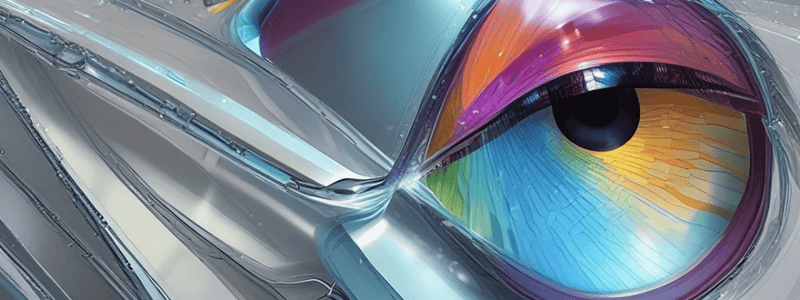Podcast
Questions and Answers
What is the ratio involved in Snell's Law for two given media?
What is the ratio involved in Snell's Law for two given media?
- Sine of the angle of incidence to the sine of the angle of refraction (correct)
- Tangent of the angle of incidence to the cosine of the angle of refraction
- Sine of the angle of incidence to the cosine of the angle of refraction
- Cosine of the angle of incidence to the sine of the angle of refraction
What type of images do concave lenses always produce?
What type of images do concave lenses always produce?
- Inverted images
- Virtual images (correct)
- Enlarged images
- Real images
What happens to light when it goes from a rarer to a denser medium?
What happens to light when it goes from a rarer to a denser medium?
- It refracts towards normal
- It scatters randomly
- It refracts away from normal (correct)
- It reflects internally
What is the critical angle defined as?
What is the critical angle defined as?
What is the formula used to calculate focal length for lenses?
What is the formula used to calculate focal length for lenses?
What is the power of a lens equal to?
What is the power of a lens equal to?
What does the refractive index (n) represent?
What does the refractive index (n) represent?
What is the principle behind the working of optical fibres?
What is the principle behind the working of optical fibres?
Which law states that the ratio of the sine of the angle of incidence to the sine of the angle of refraction is a constant for two given media?
Which law states that the ratio of the sine of the angle of incidence to the sine of the angle of refraction is a constant for two given media?
In a converging system in the human eye, which part plays a role alongside the lens?
In a converging system in the human eye, which part plays a role alongside the lens?
Flashcards are hidden until you start studying
Study Notes
Refraction
- Refraction is the bending of a ray of light when it goes from one medium to another.
- The incidence ray, normal, and refracted ray are all in the same plane.
- The ratio of the sine of the angle of incidence to the sine of the angle of refraction is a constant for two given media (Snell's Law).
Optical Fibre
- An optical fibre is a very thin transparent rod (usually of glass) through which light can travel by total internal reflection.
- Refractive index (n) is equal to real depth divided by apparent depth, or velocity in medium 1 divided by velocity in medium 2.
Laws of Refraction
- Light going from a denser to a rarer medium is refracted towards the normal.
- Light going from a rarer to a denser medium is refracted away from the normal.
- Critical angle is the angle of incidence whose corresponding angle of refraction is 90 degrees.
Lenses
- There are two types of lenses: concave (diverging) and convex (converging).
- Concave lenses produce Virtual images.
- Convex lenses produce Real and Virtual images.
- The formula 1/f = 1/u + 1/v is used to calculate focal length (f), object distance (u), and image distance (v).
- Power of a lens is equal to 1/f.
- The human eye uses a lens which, alongside the cornea, produces a converging system.
Additional Notes
- 1/f is a minus for a diverging lens.
- 1/v is minus for a virtual image.
- P = P1 + P2, where P1 and P2 are powers of the two lenses in contact.
Studying That Suits You
Use AI to generate personalized quizzes and flashcards to suit your learning preferences.




